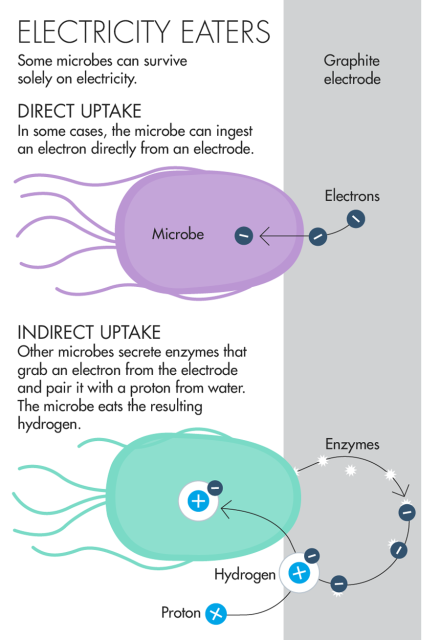Discovered a new living creature that feeds on electrons
Perhaps such bacteria will survive on Mars

Scientists have installed carbon fiber electrodes (gray) as a decoy for microbes that absorb electricity (orange). These microbes grow incredibly slowly, so the electrodes are left underground for five months. Photo: Yamini Jangir and Moh El-Naggar
For centuries, biologists have believed that all life on Earth is divided into two types: phototrophs and chemotrophs. The former receive electricity from sunlight, and the latter from energy-intensive substances in the environment, like people.
But recently it turned out that on Earth (possibly on other planets) there is a third kind of life that can eat pure electricity.
Scientists were stunned to realize how widespread a life could be that had been hidden from human eyes for a long time. After all, these microorganisms are able to live in huge quantities in mineral-rich veins deep beneath the earth's surface, in oceanic sediments under the seabed, etc.
Last year, Japanese biologists studied the deep-sea iron bacteria Acidithiobacillus ferrooxidans , which oxidize ferrous iron to ferric iron and live off the energy received. Scientists have suggested that these bacteria do not necessarily need iron - and managed to feed them clean electricity. But the Japanese failed to prove that the phenomenon of the supply of living things with pure electricity exists in nature, although they were able to detect a geoelectric current near hydrothermal sources.
American biophysicists have also been studying the phenomenon of electrotrophs in wildlife for several years. For example, Professor Moh El-Naggar (Moh El-Naggar), along with graduate student Yamini Jahangir (Yamini Jangir) in search of such exotic life climbedto a depth of one and a half kilometers of an abandoned mine in the Black Hills mountain range, which is located in the southwestern part of South Dakota. They found the old rusty pipes left by the miners - and pumped out some water for the experiment. Scientists have suggested that bacteria can exist in this water that feed on electricity, oxidizing iron in the same way as it did in the Japanese experiment.

Graduate student Yamini Jangir draws water from a pipe in an abandoned mine at a depth of one and a half kilometers. Photo: Connie A. Walter and Matt Kapust
Biophysicists placed electrodes in the extracted water sample and passed current through them, leaving the sample for five months to allow microbes to grow.
Scientists will publish the results of their scientific work in the near future. They will join numerous groups of biologists who are trying to find evidence of a natural phenomenon known as direct electron transfer .
In recent years, several discoveries have been made that confirm the theory that bacteria eating electricity are common on Earth - they are much more numerous than anyone imagined. Recent samples from the seabed off Catalina Island near California have revealed a wide variety of bacteria that extract electricity from metals and minerals.
Now scientists are trying to understand how metabolism occurs in bacteria that produce electricity directly from the environment. Japanese colleagues showed that heme-containing proteins in the membrane are involved in electron transfer from the environment. That is, the current passes directly through the membrane - a process that was previously considered impossible.

There is nothing surprising in the power supply itself. People and all other living organisms feed on electricity at the cellular level. As the Nobel laureate Albert Sainte-Giordi once romantically said about this fundamental principle of life, "life is just an electron seeking peace . " The question is how we extract it from the environment.
Professor El-Naggar and other groups of scientists are studying a new type of organism called lithoautotrophs - organisms that use inorganic substances to generate energy and are able to synthesize all components of their cells from carbon dioxide and other inorganic compounds. In other words, these bacteria extract energy from iron, sulfur, manganese and other inorganic compounds. Under certain conditions, they can live on clean electricity.
The ability of such bacteria to absorb electrons in their pure form is the so-called direct electron transfer- A very curious phenomenon, because it seems to violate the basic laws of biophysics. By law, a thick cell membrane acts as an insulator; electrons must not pass through it. “No one wanted to believe that a bacterium could take an electron from inside the cell and move it out,” said geobiologist Kenneth Nealson in a lecture last year to members of the Society for Applied Microbiology in London.
But the discovered microbes are capable of this.
Kenneth Nilson's lecture
In 2006, biologists were first able to understand how this mechanism works with the help of three specialized proteins . They are located in the membrane and form a conductive bridge through which electrons are transferred from the cell to the outside. However, scientists still continue to discuss specific details, but the very fact of the existence of such a mechanism has been proved.
After that, biologists began to search for evidence that there is a reverse transfer of electrons from the external environment into the cell. In 2009, it was proved that the bacterium Methanococcus maripaludisit can multiply on the electrode, but only last year the mechanism was discovered how it receives electricity - it turned out that for this the bacterium uses a special enzyme that pairs an electron from a conductor with a proton from water to create a hydrogen atom, a common food among bacteria.

Although this is a kind of “cheating”, that is, not direct electron transfer, but some scientists believe that other bacteria can still directly extract electrons from the environment, that is, direct electron transfer still exists.
Biologists believe that the study of new types of bacteria is still in its infancy and promises many discoveries. Professor El-Naggar compares modern experiments with the first experiments in neurology, when scientists poked electrodes into frogs to make their muscles contract.
Scientific discoveries in this area can shed light on how life began on Earth. Moreover, these discoveries significantly expand the potential habitat of microorganisms on other planets, where life can hide under the surface of the planets.

Mars surface
Such microbes can survive, for example, in the extreme conditions of Mars, because on Mars there is a lot of iron and there are underground reservoirs of water. If we have a system for extracting electrons from iron and access to water, then this is the most necessary for the metabolism of such bacteria.
So if living microorganisms are discovered during the next missions to Mars, this will not surprise biologists at all.
